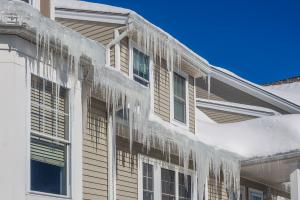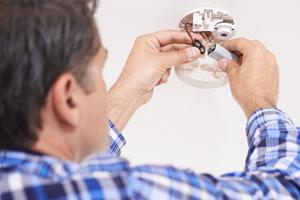You have an ice dam. Now what?

Dislodged shingles.
Structural damage.
Water-stained ceilings and walls.
These are just a few symptoms of an ice dam – a winter weather culprit. Ice dams form when the sun or warmth from your attic melts snow high up on your roof which then pools and freezes at lower, colder portions of the roof.
If you see your gutters coated in layers of ice under snow, there are things you can do problem-solve this drainage issue.
Remove ice dams safely
If you can safely reach the roof, fill a nylon stocking with calcium chloride ice melt, typically sold at any hardware store. Place the nylon stocking vertically across the ice dam, and it will melt a channel in the dam through which water can flow. Make sure the channels extend all the way to the edge of the roof.
If safety is an issue, call a pro
If you cannot reach the roof safely from the ground or question whether you need assistance, contact a professional. If you see water damage, a restoration service can dry out the walls and ceiling, preventing decay, mold and mildew from forming.
Prevent future ice dams
- Keep your gutters clean, so melting snow can flow off the roof.
- Monitor your roof in cold weather. Check for icicles, as their presence means the conditions for an ice dam to form are present.
- Use a snow rake to remove snow from your roof or hire a licensed professional snow remover or roofing contractor.
- Use heating cables on eaves and gutters to create channels for water to drain.
- Ensure proper attic ventilation and insulation so warm air doesn’t rise to the attic.
You have coverage options
Ice dams can lead to costly damage, escalating the need for protection against equipment breakdown, siding and/or roof restoration coverage and green upgrades.
Contact your independent insurance agent to review your existing insurance coverage protection and determine if you have the proper amount of coverage for contents and coverage A, as well as limits in place to protect should an ice dam damage your home.
Sources:
Insurance Institute for Business & Home Safety
Related resources
You have an ice dam. Now what?
Dislodged shingles.
Structural damage.
Water-stained ceilings and walls.
These are just a few symptoms of an ice dam – a winter weather culprit. Ice dams form when the sun or warmth from your attic melts snow high up on your roof which then pools and freezes at lower, colder portions of the roof.
If you see your gutters coated in layers of ice under snow, there are things you can do problem-solve this drainage issue.
Remove ice dams safely
If you can safely reach the roof, fill a nylon stocking with calcium chloride ice melt, typically sold at any hardware store. Place the nylon stocking vertically across the ice dam, and it will melt a channel in the dam through which water can flow. Make sure the channels extend all the way to the edge of the roof.
If safety is an issue, call a pro
If you cannot reach the roof safely from the ground or question whether you need assistance, contact a professional. If you see water damage, a restoration service can dry out the walls and ceiling, preventing decay, mold and mildew from forming.
Prevent future ice dams
- Keep your gutters clean, so melting snow can flow off the roof.
- Monitor your roof in cold weather. Check for icicles, as their presence means the conditions for an ice dam to form are present.
- Use a snow rake to remove snow from your roof or hire a licensed professional snow remover or roofing contractor.
- Use heating cables on eaves and gutters to create channels for water to drain.
- Ensure proper attic ventilation and insulation so warm air doesn’t rise to the attic.
You have coverage options
Ice dams can lead to costly damage, escalating the need for protection against equipment breakdown, siding and/or roof restoration coverage and green upgrades.
Contact your independent insurance agent to review your existing insurance coverage protection and determine if you have the proper amount of coverage for contents and coverage A, as well as limits in place to protect should an ice dam damage your home.
Sources:
Insurance Institute for Business & Home Safety
Related resources
You have an ice dam. Now what?
Dislodged shingles.
Structural damage.
Water-stained ceilings and walls.
These are just a few symptoms of an ice dam – a winter weather culprit. Ice dams form when the sun or warmth from your attic melts snow high up on your roof which then pools and freezes at lower, colder portions of the roof.
If you see your gutters coated in layers of ice under snow, there are things you can do problem-solve this drainage issue.
Remove ice dams safely
If you can safely reach the roof, fill a nylon stocking with calcium chloride ice melt, typically sold at any hardware store. Place the nylon stocking vertically across the ice dam, and it will melt a channel in the dam through which water can flow. Make sure the channels extend all the way to the edge of the roof.
If safety is an issue, call a pro
If you cannot reach the roof safely from the ground or question whether you need assistance, contact a professional. If you see water damage, a restoration service can dry out the walls and ceiling, preventing decay, mold and mildew from forming.
Prevent future ice dams
- Keep your gutters clean, so melting snow can flow off the roof.
- Monitor your roof in cold weather. Check for icicles, as their presence means the conditions for an ice dam to form are present.
- Use a snow rake to remove snow from your roof or hire a licensed professional snow remover or roofing contractor.
- Use heating cables on eaves and gutters to create channels for water to drain.
- Ensure proper attic ventilation and insulation so warm air doesn’t rise to the attic.
You have coverage options
Ice dams can lead to costly damage, escalating the need for protection against equipment breakdown, siding and/or roof restoration coverage and green upgrades.
Contact your independent insurance agent to review your existing insurance coverage protection and determine if you have the proper amount of coverage for contents and coverage A, as well as limits in place to protect should an ice dam damage your home.
Sources:
Insurance Institute for Business & Home Safety
Related resources
You have an ice dam. Now what?
Dislodged shingles.
Structural damage.
Water-stained ceilings and walls.
These are just a few symptoms of an ice dam – a winter weather culprit. Ice dams form when the sun or warmth from your attic melts snow high up on your roof which then pools and freezes at lower, colder portions of the roof.
If you see your gutters coated in layers of ice under snow, there are things you can do problem-solve this drainage issue.
Remove ice dams safely
If you can safely reach the roof, fill a nylon stocking with calcium chloride ice melt, typically sold at any hardware store. Place the nylon stocking vertically across the ice dam, and it will melt a channel in the dam through which water can flow. Make sure the channels extend all the way to the edge of the roof.
If safety is an issue, call a pro
If you cannot reach the roof safely from the ground or question whether you need assistance, contact a professional. If you see water damage, a restoration service can dry out the walls and ceiling, preventing decay, mold and mildew from forming.
Prevent future ice dams
- Keep your gutters clean, so melting snow can flow off the roof.
- Monitor your roof in cold weather. Check for icicles, as their presence means the conditions for an ice dam to form are present.
- Use a snow rake to remove snow from your roof or hire a licensed professional snow remover or roofing contractor.
- Use heating cables on eaves and gutters to create channels for water to drain.
- Ensure proper attic ventilation and insulation so warm air doesn’t rise to the attic.
You have coverage options
Ice dams can lead to costly damage, escalating the need for protection against equipment breakdown, siding and/or roof restoration coverage and green upgrades.
Contact your independent insurance agent to review your existing insurance coverage protection and determine if you have the proper amount of coverage for contents and coverage A, as well as limits in place to protect should an ice dam damage your home.
Sources:
Insurance Institute for Business & Home Safety




